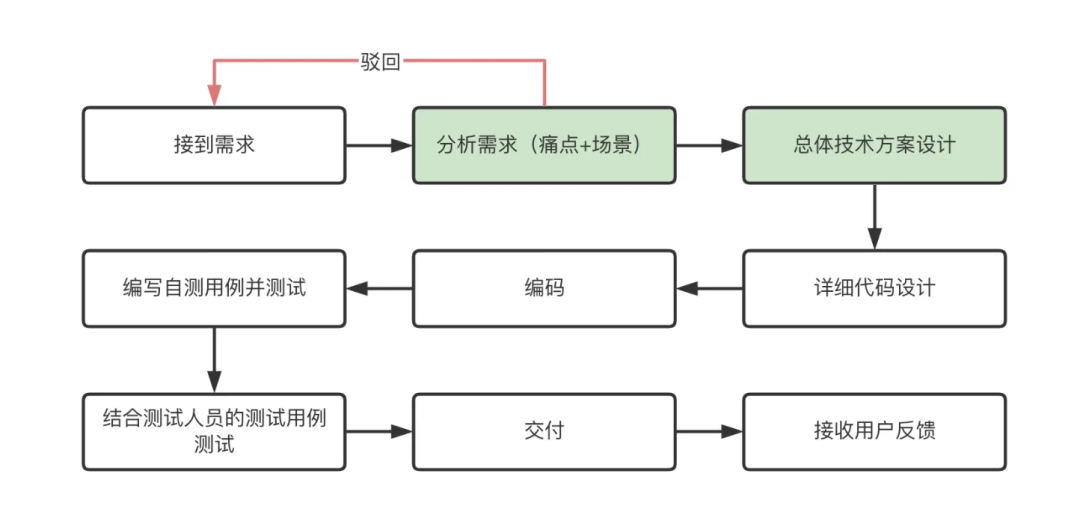近期组员接手了一个“古老“的初始由后端大佬写的前端项目,业务层面的组件复用,全靠是 copy 相同代码咱不说,经过不同大佬们的维护,代码风格更是千奇百怪。该前端项目还在正常迭代更新,又不可能重写,面对 💩 一样的代码,两个接手的小前端抱着欲哭无泪,瑟瑟发抖。见状,只能安慰之,暂时发挥啊 Q 精神,规范自己的新代码,然后每次迭代开发任务重构一两个旧组件,此过程持续 2-3 个月后,上 eslint 和 prettier 自动化检测语法和格式化代码。
本着“代码不规范,新人两行泪”的警示,总结出如下 JavaScrip、ES6 和 Vue 单文件组件相关代码风格案例,供大家参考。
开发流程规范
这里可能有小伙伴有疑问了,开发流程规范不是项目经理定的吗 🤔️,跟我有什么关系?
这里想告诉大家的是,开发流程在一定程度上应该是由我们自己来掌控。不管是传统开发的模式还是敏捷开发的模式,对于开发者来说核心依旧是高质高效的完成用户提出的需求。
不少开发者在拿到产品经理的需求后就开始急匆匆的写代码,以此来体现他们的高效,但往往却因为需求理解不到位和前期代码欠缺设计导致 bug 率高和返工。
如何找到适合自己的开发流程是需要依靠经验来支撑的,需要反复总结和思考,最终达到高质高效完成的目的。

在接收到需求后应第一时间去了解这个需求的背景是什么?这么做到底有没有解决用户的痛点?或者说用户更深层次的需求是什么?如果团队的产品经理经验不丰富,往往可以在这个阶段砍掉很多不合理的需求(这一点真的很重要)。
对于复杂大功能往往还需要进行技术方案调研和技术方案设计,并输出详细的设计文档。涉及到细节上,则需要将数据流走向、组件设计等通过脑图的形式呈现出来。
代码格式化规范
由于每个开发者的 IDE 不同,即使 IDE 相同也会因为每个人的配置不一样导致格式化的结果不一样。如何确保团队内开发人员采用统一的格式化配置呢?
这里给推荐大家使用 prettier,它内置了一套格式化的规则,具体配置:
1、安装依赖
1 | npm install --save-dev --save-exact prettier |
2、创建一个空配置文件,让编辑器和其他工具知道你正在使用 Prettier
1 | echo {}> .prettierrc.json |
3、创建一个.prettierignore 文件,让 Prettier CLI 和编辑器知道哪些文件不能格式化
1 | Ignore artifacts: |
4、配置编辑器(VScode 为例)
IDE 中安装 Prettier-Code Formater 插件

找到 IDE 中设置模块,搜索 format On Save,勾上这个就可以了。
现在当我们 Ctrl + S 保存代码时,插件就会帮助我们自动格式化了。
这里有小伙伴要问了,要是有人将没有格式化的代码提交上去怎么办?
这时候就需要在 git commit 的阶段自动将提交的代码进行格式化,这里我们借助工具 husky,它主要可以帮助我们在 git 阶段检查提交消息、运行测试、检查代码等。没接触过的小伙伴可以去官网了解一下,配置如下:
1、安装 husky 和 lint-staged
1 | npm install --save-dev husky lint-staged |
2、然后将以下内容添加到 package.json 中
1 | { |
这段配置的意思是:当执行 git commit 阶段前,先执行 lint-staged,lint-staged 中的内容就是对暂存区的文件执行格式化的命令。
其他:若使用的是脚手架工具搭建的项目,会自带 eslint 配置(eslintConfig)。prettier 和 eslint 会有一些配置上的冲突,这个时候需要安装 eslint-config-prettier 以使 ESLint 和 Prettier 相互配合,安装完后在.eslintrc 中配置(以 Create-React-App 为例)
1 | "eslintConfig": { |
这样就可以用”prettier”的部分规则覆盖前面的规则,让它们都能正常工作。
JS/TS 代码规范插件
JS/TS 主流的大致有这几种:
Airbnb JavaScript Style Guide
Google JavaScript Style Guide
Idiomatic JavaScript Style Guide
JavaScript Standard Style Guide
jQuery JavaScript Style Guide
比较推荐使用 Airbnb JavaScript Style Guide,它在 Github 上足有 12 万 star,几乎覆盖了 JavaScript 的每一项特性。
具体配置:
1、安装依赖
1 | npm install eslint --save-dev |
2、生成配置文件
1 | npm init @eslint/config |
跟着终端中的提示,按照自身需求一步步选择即可。
有了具体的规范后,我们同样需要使用工具去约束:还是通过在 git commit 阶段校验,若不通过则取消提交。
配置(还是在 package.json 中的 lint-staged ):
1 | "lint-staged": { |
注意:这里如果选用的 Typescript,则会默认使用@typescript-eslint/parser 解析器,官方为了追求更快的解析速度,并不会对.ts 文件中的类型进行检查,只会做语法检测。
如果需要对类型也进行检测,需要在 extends 中加上 plugin:@typescript-eslint/recommended-requiring-type-checking。
索性这里换了另一种方式:在 pre commit 中执行 yarn run tsc,这里的意思是对项目中 ts 文件进行类型检测,默认会读取根目录中的 tsconfig.json 配置。
这种方式并不完美,它的弊端就在于全量检测,如果项目不大还好,若是项目代码量够多,检测 10-20s 也是常有的事。
CSS 代码规范插件
CSS 检查代码规范使用 stylelint 插件,规范则推荐使用 stylelint-config-standard
1、安装
1 | npm install --save-dev stylelint stylelint-config-standar |
2、在项目的根目录中创建一个配置文件.stylelintrc.json,内容如下
1 | { |
3、解决与 prettier 配置的冲突
1 | npm install --save-dev stylelint-config-prettier |
4、将下面配置复制到.stylelintrc.json 中
1 | { |
5、在 git commitv 阶段进行检测
1 | "lint-staged": { |
Git commit 规范
git commit 规范主要可以帮助开发人员在 code review 期间更容易理解提交的内容,现在大部分主流 commit 规范都是基于Angular 团队的规范而衍生出来的,它的 message 格式如下:
1 | <type>(<scope>): <subject> |
每个提交消息都包含一个 subject、一个 body 和一个 footer (中间使用空行分割),提交信息的任何一行不能超过 100 个字符。
👉 type 主要有以下几种类型:
- feat: 一个新特性
- fix: 修复 bug
- docs: 文档修改
- style: 不影响代码含义的更改(空格、格式、缺少分号等)
- refactor: 代码重构
- perf: 优化性能
- test: 测试用例修改
- chore: 对构建过程或辅助工具和库的更改,例如文档生成
👉 scope:可以是影响范围的任何内容。
👉 subject:包含对更改的简洁描述,规则:
- 使用陈述语句
- 第一个字母不要大写
- 末尾没有点 (.)
👉 body:commit 具体修改内容, 可以分为多行,应该包括改变的动机,并与以前的行为进行对比。
👉 footer: 一些备注, 通常是修复的 bug 的链接。
截取一张开源库的 commit,example:

有了规范后,我们需要通过工具去约束:commitlint。它要做的就是在我们每次提交 git commit 的时候,都会帮我们检查 commit message 是否符合一定的规范,如果不符合,就让这次提交失败。
具体配置:
1 | 安装 commitlint cli 和 conventional config |
Javascript 代码风格
使用有意义的变量名称
变量的名称应该是可描述,有意义的, JavaScript 变量都应该采用驼峰式大小写 ( camelCase) 命名。
1 | // bad ❌ |
布尔变量通常需要回答特定问题,例如:
1 | isActive |
避免添加不必要的上下文
当对象或类已经包含了上下文的命名时,不要再向变量名称添加冗余的上下文。
1 | // bad ❌ |
避免硬编码值
1 | // bad ❌ |
使用有意义的函数名称
函数名称需要描述函数的实际作用,即使很长也没关系。函数名称通常使用动词,但返回布尔值的函数可能是个例外 — 它可以采用 是或否 问题的形式,函数名也应该是驼峰式的。
1 | // bad ❌ |
限制参数的数量
尽管这条规则可能有争议,但函数最好是有 3 个以下参数。如果参数较多可能是以下两种情况之一:
- 该函数做的事情太多,应该拆分。
- 传递给函数的数据以某种方式相关,可以作为专用数据结构传递。
1 | // bad ❌ |
避免在一个函数中做太多事情
一个函数应该一次做一件事,这有助于减少函数的大小和复杂性,使测试、调试和重构更容易。
1 | // bad ❌ |
避免使用布尔标志作为参数
函数含有布尔标志的参数意味这个函数是可以被简化的。
1 | // bad ❌ |
避免写重复的代码
如果你写了重复的代码,每次有逻辑改变,你都需要改动多个位置。
1 | // bad ❌ |
避免副作用
在 JavaScript 中,你应该更喜欢函数式模式而不是命令式模式。换句话说,大多数情况下我们都应该保持函数纯洁。副作用可能会修改共享状态和资源,从而导致一些奇怪的问题。所有的副作用都应该集中管理,例如你需要更改全局变量或修改文件,可以专门写一个 util 来做这件事。
1 | // bad ❌ |
另外,如果你将一个可变值传递给函数,你应该直接克隆一个新值返回,而不是直接改变该它。
1 | // bad ❌ |
使用非负条件
1 | // bad ❌ |
尽可能使用简写
1 | // bad ❌ |
避免过多分支
尽早 return 会使你的代码线性化、更具可读性且不那么复杂。
1 | // bad ❌ |
优先使用 map 而不是 switch 语句
既能减少复杂度又能提升性能。
1 | // bad ❌ |
使用可选链接
1 | const user = { |
避免回调
回调很混乱,会导致代码嵌套过深,使用 Promise 替代回调。
1 | // bad ❌ |
处理抛出的错误和 reject 的 promise
1 | // bad ❌ |
只注释业务逻辑
1 | // bad ❌ |
ES6 优化原生 JS(ES5) 代码风格
使用默认参数
1 | // bad ❌ |
对象结构取值
1 | const obj = { |
ES6 的解构赋值虽然好用。但是要注意解构的对象不能为 undefined、null。否则会报错,故要给被解构的对象一个默认值。
1 | const { a, b, c, d, e } = obj || {} |
拓展运算符合并数据
合并数组或者对象,用 ES5 的写法有些冗余
1 | const a = [1, 2, 3] |
拼接字符
1 | const name = '小明' |
includes 替代多条件判断
1 | // bad ❌ |
列表查找某一项
1 | const a = [1, 2, 3, 4, 5] |
数组扁平化
1 | // bad ❌ |
可选链操作符获取对象属性值
1 | // bad ❌ |
动态对象属性名
1 | // bad ❌ |
判断非空
1 | // bad ❌ |
Vue 组件风格
Vue 单文件组件风格指南内容节选自 Vue 官方风格指南。
组件数据
组件的 data 必须是一个函数。
1 | // bad ❌ |
单文件组件文件名称
单文件组件的文件名应该要么始终是单词大写开头 (PascalCase),要么始终是横线连接 (kebab-case)。
1 | // bad ❌ |
紧密耦合的组件名
和父组件紧密耦合的子组件应该以父组件名作为前缀命名。
1 | // bad ❌ |
自闭合组件
在单文件组件中没有内容的组件应该是自闭合的。
1 | <!-- bad --> |
Prop 名大小写
在声明 prop 的时候,其命名应该始终使用 camelCase,而在模板中应该始终使用 kebab-case。
1 | // bad ❌ |
1 | <!-- bad --> |
指令缩写
指令缩写,用 : 表示 v-bind: ,用 @ 表示 v-on:
1 | <!-- bad --> |
Props 顺序
标签的 Props 应该有统一的顺序,依次为指令、属性和事件。
1 | <my-component |
组件选项的顺序
组件选项应该有统一的顺序。
1 | export default { |
组件选项中的空行
组件选项较多时,建议在属性之间添加空行。
1 | export default { |
单文件组件顶级标签的顺序
单文件组件应该总是让顶级标签的顺序保持一致,且标签之间留有空行。
1 | <template> ... </template> |